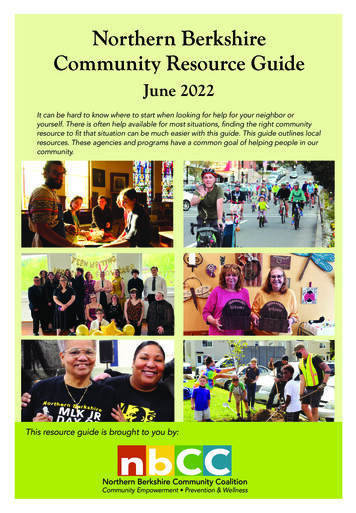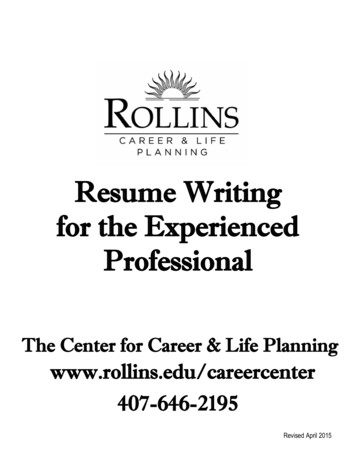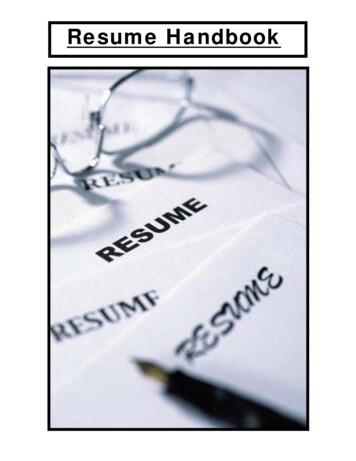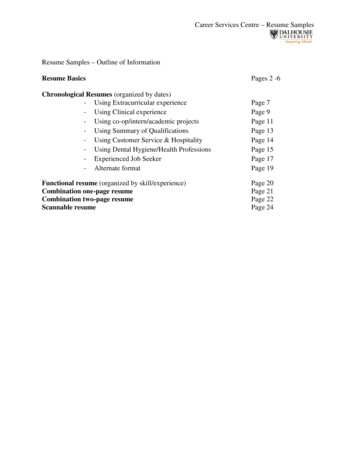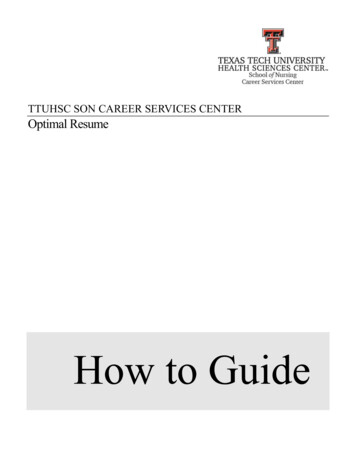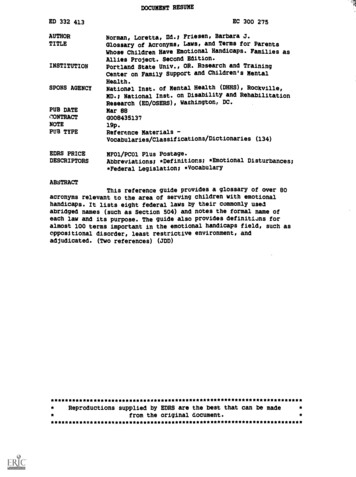
Transcription
DOCUMENT RESUMEEC 300 275ED 332 413AUTHORTITLEINSTITUTIONSPONS AGENCYPUB DATEi7ONTRACTNOTEPUB TYPEEDRS PRICEDESCRIPTORSNorman, Loretta, Ed.; Friesen, Barbara J.Glossary of Acronyms, Laws, and Terms for ParentsWhose Children Have Emotional Handicaps. Families asAllies Project. Second Edition.Portland State Univ., OR. Rosearch and TrainingCenter on Family Support and Children's MentalHealth.National Inst. of Mental Health (DHHS), Rockville,MD.; National Inst. on Disability and RehabilitationResearch (ED/OSERS), Washington, DC.Mar 88000843513719p.Referonce Materials Vocabularies/Classifications/Dictionaries (134)MF01/PC01 Plus Postage.Abbreviations; *Definitions; *Emotional Disturbances;*Federal Legislation; *VocabularyABSTRACTThis reference guide provides a glossary of over 80acronyms relevant to the area of serving children with emotionalhandicaps. It lists eight federal laws by their commonly usedabridged names (such as Section 504) and notes the formal name ofeach law and its purpose. The guide also provides definitiJns foralmost 100 terms important in the emotional handicaps field, such asoppositional disorder, least restrictive environment, andadjudicated. (Two references) **************************Reproductions supplied by EDRS are the best that can be madefrom the original ******************************
U,t DEPARTMENT OP EDUCATIONOffice ol Educalbruil Research and ImprovementEDU yTIONAL RESOURCES INFORMATIONCENTER IERICtAsdocument has been reproducedreceived 1mm the person or organizationasoriginating it0 Minor changes have been made to improvereproductior. 1,11410yPoints of view at opimons stated in this docomerit do not necessarily represent officialOERI Position or policyGLOSSARYOFACRONYMS, LAWS, AND TERMSFORPARENTS WHOSE CHILDREN HAVE EMOTIONAL HANDICAPSLoretta Norman, EditorBarbara J. Friesen, Principal Investigator(CIFamilies As Allies ProjectResearch and Training Center on Family Supportand Children's Mental HealthRe gional Research Institute for Human ServicesPortland State UniversityPortland, Oregon 97207-0751(503) 725-4040March 1988Second EditiontqBEST COPY AVAILABLE
This publication was developed with funding from the National Institute onDisabiiity and Rehabilitation Research, U.S. Department of Education and theNational Institute of Mental Health, U.S. Department of Health and HumanServices (NIDRR grant number G008435137). The content of this publicationdoes not necessarily reflect the views or policies of the funding agencies.
TABLE OF CONTENTSAcronymsLaws and RegulationsTerms4
:1Z",GLOSSARYACRONYMSA&DAlcohol and drug.ACCHAssociation for the Care of Children's Health. A multidisciplinaryassociation of professionals and parents that promotes qualitypsychosocial health care for children and their families.ACSWDenotes certification by the academy of Certified Social Workers.Requires 3,000 hours of paid supervised work experience beyond theMSW and an examination.ADDAttention deficit disorder. See Attention-deficit HyperactivityDisorder.ADHDAttention-deficit hyperactivity disorder. A condition characterized bya failure to remain attentive in various situations, especially in theschool and home.AMIAlliance for the Mentally Ill. See NAM!.ARCAssociation for Retarded Citizens. Support group and program forfamilies with children who are mentally retarded.BDBehavior disordered.CANChild abuse and neglect.CAPCenter Accreditation Project. A national certification project forquality child care programs.CASACourt-appointed special advocate.CASSPChild and Adolescent Services System Program. Funded by the NationalInstitute of Mental Health in 28 states and three local communities toplan, develop and implement services for children and adolescents withserious emotional impairments.CCDCrippled Children's Division. A program for children with physicalimpairments.CDAChild Development Associate. Training and certification program forHead Start and child care staff.CECCouncil on Exceptional Children. Professional organization for personsserving exceptional school age children.CMHCCommunity Mental Health Center. A facility providing local mental5
health services. May be run by the county or state or be a private, nonprofit organization.CMIChronically mentally ill.CPCerebral palsy.CPSChild Protective Services. State or county agency responsible foraddressing issues of child abuse and neglect.CSPCommunity Support Program. Federally funded programs (through theNational Institute of Mental Health) to develop community supportsystems for persons with longterm psychiatric disabilities.CSTChild Study Team. A team consisting of the parents of a child with ahandicap and professionals serving the child, convened to develop longand short range goals for the child's progress.DDDevelopmentally disabled (or delayed). Persons whose diagnosis mayinclude mental retardation, epilepsy, autism, cerebral palsy or similarimpairments. (See also MR/DD)DECDivision for Early Childhood of the Council for Exceptional Children.The professional organization for persons serving preschool childrenwith handicaps.DHHSUnited States Department of Health and Human Services.DOEDepartment of Education (United States or state).DSM IIIR Diagnostic and Statistical Manual of Mental Disorders (3rd EditionRevised). A classification system for' mental illnesses developed by theAmerican Psychiatric Association.D.S.W.Doctorate degree in social work.EDEmotionally disturbed.Ed.D.Indicates doctoral degree in education.EEGElectroencephalogram. A test which measures electrical impulses in thebrain.EHEmotionally handicapped.EHAThe Education for All Handicapped Children Act. See Public Law 94142.FAAFamilies as Allies Project, Research and Training Center, Portland StateUniversity, Portland, Oregon.2
FAPEA free and appropriate public education.FERPAFamily Educational Rights and Privacy Act. (Student School RecordsAct.) Federal regulation governing confidentiality of student recordsand parental rights of access and consent to release.I&RInformation and Referral.ICFMRIntermediate Care Facility for the Mentally Retarded.IEPIndividualized Education Program. A written plan of services for achild with a handicap developed jointly by parents and school personnelas required under Public Law 94-142.IFSPIndividual Family Services Plan. Written objectives for each child 0-2,addressing both the child's and family's needs in the early interventionprogram.LCSWDenotes certification by a state as a licensed clinical social worker.Such licensure often requires at least two years experience with a directclient caseload under supervision. (See ACSW and RCSW).LEALocal Educational Agency.LRELeast Restrictive Environment.MBDMinimal brain dysfunction. See brain injured in the Terms section ofthe glossary.MEDMental or emotional disturbance (or disorder).MHAMental Health Association. A non-profit citizens organization dedicatcdto legislative advocacy on behalf of the mentally ill and children withdisturbances. Other services include public education and prevention ofabuse and family problems and sponsorship of parent support groups.MIMentally impaired/ill.MMPIMinnesota Multiphasic Personality Inventory. A personality assessmenttool widely used in making psychological evaluations. Normally givento persons 16 years of age and older.MPBMigrant Program Branch. A federal Head Start program serving NativeAmerican children who reside on reservations and migrant children.MPHIndicates a master's degree in public health.MRMentally retarded.MR/DDMentally retarded/Developmentally disabled (or ,ielayed).3
M.S.W.Master's degree in social work.NAEYCNational Association for the Education of Young Children. Aprofessional organization for persons in early childhood education.NAMINational Alliance for the Mentally Ill. A self-help organization ofmentally ill persons, their families and friends.NICCYH National Information Center for Children and Youth with Handicaps.A free information service that assists parents, educators, caregiversand others in ensuring that all children and youth with disabilities havea better opportunity to reach their fullest potential.NIDRRNational Institute on Disability and Rehabilitation Research. A federalagency that funds research and services for persons with physical ormental disabilities. Part of the United States Department of Education.NIMHNational Institute of Mental Health. A federal agency that sponsorsresearch and demonstration activities to increase knowledge andimprove services in the field of mental health. Part of the UnitedStates Department of Health and Human ServicesNMHANational Mental Health Association. See MHA.OTOccupational therapy.P&AProtection and Advocacy. State agency providing advocacy activities onbehalf of persons with developmental disabilities and mental illness.See Public Law 99-319.PDDPervasive developmental disorder.Ph.D.Indicates a doctoral degree in any of a wide range of disciplines(sociology, psychology, anthropology, mathematics, etc.)PICParent Information Center. Parent information and support programsfunded by the United States Department of Education.PTPhysical therapy.PTIParent Training and Information Centers. See PIC.R&RResource and referral.R&TResearch and Training Centers (or R & T Centers). Thirty-six centersfunded by NIDRR to provide research, training and technical assistanceto consumers with disabilities and service providers. Two centers focuson the needs of children and youth with emotional handicaps. Thesetwo centers are also supported by NIMH and are located at theUniversity of South Florida and at Portland State University in Oregon.4
RCSWDenotes certification by s state as a registered clinical social worker.Such licensure often requires at least two years supervised experiencewith a direct client caseload. (Sec also ACSW and LCSW).RNRegistered nurse.RRCRegional Resource Centers. Federally funded programs responsible fortraining and technical assistance to staff who serve school age childrenwith Fandicaps.RRIRegional Research Institute for Human Services. Portland StateUniversity, Portland, Oregon.SATStandardized achievement test.SEAState educational agencySEDSeriously emotionally disturbed. Also commonly EH for "emotionallyhandicapped."SMHRCY State Mental Health Representatives for Children and Youth. Theprofessional people in each state responsible for the planning,development and management of public child mental health services. Adivision of the National Association of State Mental Health ProgramDirectors.SSSocial services.SSASocial Security Administration. A federal agency that administerssocial security and disability benefits.SSDISocial Security Disability Insurance. A federal program administeredby SSA.SSISupplemental Security Income. A federal program administered by SSA.VRVocational Rehabilitation. Also commonly VRD or DVR; "D" forDepartment.WISCSee Wechsler Tests in Terms section of glossary.WRATWide Range Achievement Test. A short test for evaluating basic skillsof spelling, arithmetic and reading. The WRAT is widely used byschools for testing educational achievement.59
LAWS AND REGULATIONSPublic Law(P.L.) 94-142Public Law(P.L.) 94-457Public Law(P.L.) 96-272Public Law(P.L.) 96-398The Education for All Handicapped Children Act. A federal lawthat guarantees a free, appropriate public education for allchildren with handicaps. Also known as 94-142.1986 Amendments to Education for All Handicapped ChildrenAct. A federal law providing free and appropriate educationand "related services" to preschool age children with handicaps.Adoption Assistance and Child Welfare Act of 1980. Federal lawoutlining procedures for the placement of children out of homeby state child welfare agencies.Mental Health Systems Act. (190) Encourages the developmentof systems of care. Policies contained in the Act received nospecific funding.Public Law(Pl.) 99-319Protection and Advocacy for Mentally Ill Individuals Act of1986. Federal law allocating funds to each state for advocacyactivities on behalf of persons with developmental disabilities ormental illness.Section 504A part of the Rehabilitation Act of 1974. This section statesthat no program or activity receiving federal funds can exclude,deny benefits to, or discriminate against any person on the basisof handicap. It also requires access for people who arehandicapped to all public buildings. Also known as 504.Title XIXFederal program of medical aid designed for those unable toafford fee for service medical care. (Medicaid). With a Medicaidcard, individuals can purchase medical service as needed in thecommunity. Part of the Social Security Act.(19)Title XX(20)Federal program supports social services at the state and locallevel contingent on the development of a plan which includes thegoals and target groups for such sarvices. Part of the SocialSecurity Act.60
TERMSActing OutSelf-abusive, aggressive, violent and/ordisreptive behavior.AcuteMarked by a sudden onset, sharp rise, andlasting a short time, demanding urgent attentionAdjudicatedComing under the protection or guardianshipand jurisdiction of the court.Adjustment DisorderMa !adaptive reaction in adolescents to anidentifiable source.AdvocacyThe process of actively supporting the cause ofan individual (case advocacy) or group (classadvocacy), speaking or writing in favor of, orbeing intercessor or defender. Action to assurethe best possible services for or intervention inthe service system on behalf of an individual orgroup.AffectFeeling, emotion.AffectiveRelated to or arising from feelings andemotions.Affective DisorderA disorder of mood (feeling, emotion). Refersto a disturbance of mood and other symptomsthat occur together for a minimal duration oftime and Ire not due to other physical or mentalillness.Anxiety DisorderExaggerated or inappropriate responses to theperception of internal or external dangers.Appropriate EducationAn individual education program speciallydesigned to meet the unique needs of a childwho has a handicap.AssessmentSee Evaluation.Autistic DisorderA disorder (usually appearing by cge 2)characterized by lack of communication, lack ofsocial skills, withdrawal and developmentaldelays.Avoidant DisorderAvoiding the establishment of new interpersonalcontacts to the extent that social functioning isimpaired.711
Behavior DisorderedDisplaying behaviors over a long period of tin,:which significantly deviate from sociallyacceptable norms for the individual'. age andsituation.Bipolar DisorderA mood disorder with elevated mood, usuallyaccompanied by a major depressive episode.Brain-InjuredA condition in which an individual before,during, or after birth has received an injury toor suffered an infection of the brain. As aresult of such organic impairment, there may bedisturbances that prevent or impede the normallearning process.Case ManagtmentCase ManagerA service that assists clients to obtain andcoordinate community resources such as incomeassistance, education, housing, medical care,treatment, vocational preparation, andrecreation.An individual who organizes services for aclient.Child PsychiatristA physician (M.D.) specializing in mental,emotional, or behavior disorders in children andadolescents. Qualified to prescribe medications.Child PsychologistIndicates a mental health professional with aPh.D. in psychology who administer tests,evaluates and treats children's emotionaldisorders. Cannot prescribe medication. SeePsychiatrist.Child WelfareA field of social service concerned with the careand well being of children.Child Welfare AgencyAn administrative organization providingprotection to children, and supportive servicesto children and their families.Childhood DepressionSee Major Depressive Episode.ChronicMarked by long duration or frequent recurrence.Clinical PsychologistA mental health professional trained toadminister psychological tests, evaluate andtreat emotional disorders. Cannot prescribemedication. See Psychiatrist.
Clinical Social WorkerA mental health prafessianal trained to provideservices to individuals, families, and groups.Cannot prescribe medication. See Psychiatrist.Community SupportAn organized system of care to assist adultswith long-term psychiatric disabilities to meettheir needs and develop their potentials withoutbeing unnecessarily isolated or excluded fromthe community.SystemConduct DisorderRepetitive and persistent patterns of behaviorthat violate either the rights of others or ageappropriate social norms or rules.Day TreatmentCommunity based, non-residential program ofservices for children. It is the most intensiveprogram available that still alluws i;ic child toremain in the home.Defensive BehaviorBehavior that is for the purpose of protectingthe individual or avoiding unpleasant ideas,thoughts, and consequences.DelinquentA child or youth (usually under 18) who isfound by a juvenile court to have broken d law.Deviant BehaviorBreaking formal or informal rules or lawsrelative to social customs or norms, includingsexual behavior.Due Process HearingA formal legal proceeding presided over by animpartial public official who listens to bothsides of the dispute and renders a decision basedupon the law.Emotionally DisturbedA child or adolescent who exhibits behavioral,emotional and/or social impairment thatconsequently disrupts the child's or adolescent'sacademic and/or developmental progress, family,and/or interpersonal relationships.orEmotionally HandicappedEvaluationA process conducted by mental healthprofessionals that results in an opinion about achild's mental or emotional capacity, and mayinclude recommendations about treatment orplacement. See Assessment.Exceptional ChildrenChildren whose performance deviates from thenorm (either above or below) to the extent thatspecial programming is needed.9 13
Family Support ProgramPrograms available in the community that assistchildren and their families so that children canremain in their homes.Family TherapyThe therapeutic technique in which familymembers are :. en together in order to improvefamily communication and create moresatisfying interactions.Guidance CounselorAn individual working in a school who istrained to do screening, evaluations, and careerand academic advising.HyperactivityExc-ssive movement or activity. A feature ofAttention-deficit Hyperactivity Disorder.Identity DisorderSevere subjective distress caused by anadolescent's inability to echieve an integratedsense of self.Individualized EducationProgram (IEP)A written plan of services for a childwith a handicap developed jointly by parentsand school personnel.InpatientPsychiatric services in a residential, oftenhospital setting.Least RestrictiveEnvironmentAn educational, treatment or living situationthat provides appropriate services or programsfor a child with handicaps while imposing asfew limitations or constraints as possible.MainstreamingPlacement of a child with a handicap in theregular classroom.Major Depressive EpisodeA mood disorder with a depressed mood thatmay accompany a manic episode.MedicaidTitle XIX (19) funding for medical services forindividuals receiving public assistance, or whoarc blind or disabled.Mentally II1A general tern1 applied to individuals sufferingfrom severe emotional problems or psychiatricdisorders.Neurologically ImpairedHaving damage or deficiency in the nervoussystem of the body.NeurologistA physician (M.D.) specializing in diagnosis andtreatment of diseases of the nervous system.101.4
Oppositional DisorderThe covert display of underlying aggression bypatterns of obstinate, but generally passivebehavior. Children with this disorder oftenprovoke adults or other children by the use ofnog'. tivism, stubbornness, dawdling,procrastination, and other behaviors.OutpatientTreatment available in the community at a localmental health clinic or from private therapists.Children receiving this type of treatmentgenerally live at home.Overanxious DisorderDift use fears and worries that cannot bc tracedto specific problems or stresses.Parent Training1.Classes or individual instruction designed toimprove parenting skills in such areas asdiscipline, consistency, and communication.2.Parent Training and Information (PTI)provides information and assistance toparents so they can be knowledgeable andeffective advocates within service andpolicy systems.Pediatric RNA registered nurse specializing in the care ofchildren.Pervasive DevelopmentalDisorderExtreme distortions or delays in thedevelopment of social behavior and language.Post-traumatic Stress DisorderAnxiety disorder following a traumatic event.Psychiatric NurseA registered nurse specializing in the care ofpatients with emotional or psychiatric disorders.Psychiatric Social WorkerSocial worker specializing in work withpsychiatric patients and their families.PsychiatristA physician (M.D.) specializing in mental,emotional, or behavioral disorders. Qualified toprescribe medications.PsychoanalystA person who diagnoses and treats emotionaldisorders through special techniques that explorea patient's mental and emotional makeup. Thisap;:c.leh to treatment is usually long term.PsychologistSee Crinical Psychologist.111 5
Psychosi:A general term used to describe any of severalmental disorders characterized by socialwithdrawal, distortions of reality, loss ofcontact with environment and disintegration ofpersonality.PsychotherapistA mental health professional who providespsychotherapy.PsychotherapyA broad term applied to a variety of approachesto the treatment of mental and emotionaldisorders.Residential TreatmentLive-in facilities that provide treatment andcare for children with emotional disturbanceswho require continuous medication and/orsupervision or relief from environmentalstresses.Respite ServicesTemporary care given to an individual for thepurpose of providing a period of relief to theprimary caregivers. Respite is used to decreasestress in the homes of persons with disabilitiesor handicaps, thereby increasing caregivers'overall effectiveness.SchizophreniaA serious mental disorder characterized byverbal incoherence, severely impairedinterpersonal relations, disturbance in thoughtprocesses, cognitive deficits, and inappropriateor blunted affect. The child may also exhibithallucinations or delusions.School PhobiaFear of going to school associated with anxietyabout leaving home and family members.School PsychologistA mental health professional who works inschools.School Social WorkerA social worker who works in schools. (SeeSocial Worker)ScreeningAn assessment or evaluation for the purpose ofdetermining the appropriate services for aclient.612
Seriously EmotionallyDisturbedorSeverely EmotionallyDisturbedA child or adolescent who exhibits behavioral,emotional and/or social impairment thatconsequently disrupts the child's or adolescent'sacademic and/or developmental progress, familyand/or interpersonal relationships, and hasimpaired functioning that has continued for atleast one year, or has an impairment of shortduration and high severity.Simple PhobiaCharacterized by persistent irrational fears of aspecific object, activity, or situation.Social WorkerA professional trained to provide services toindividuals, families, and groups.Socially MaladjustedHaving extreme difficulty dealing appropriatelywith other people.SociopathA term sometimes used to describe persons withextreme disregard for and hostility towardsociety.Status OffenseNon-criminal behavior of a child such asrunning away, truancy, and curfew violation,that can result in juvenile court action.Support ServicesTransportation, financial help, support groups,homemaker services, respite services, and otherspecific services to children and families.TreatmentChanging behaviors or other conditions relatedto the child's emotional handicap; and/orhelping the individual and his or her family tocope with the handicap.Treatment ModalityThe method that is used to treat a child; forexample, behavior management is one treatmentmodality and play therapy is another.Wechsler TestsA series of verbal and performance tests widelyused in school systems. Three types are used:WPPSE: The Preschool and Primary Scale ofIntelligence2. WAIS-R: The Adult Intelligence Scale(Revised)3. WISC or WISC-R: The Intelligence Scale forChildren (Revised)1.13
Withdrawing BehaviorBehavior charactek ized oy reduced interest in orcontact with other people, and can includeabsence of speech, regression to babyhood,exhibition of many fears, depression, refusingcontacts with other people.1814
GLOSSARY ACKNOWLEDGEMENTSThe majority of the information in this glossary is taken from the text of TakingCharge:A Handbook for Parents Whose Children Have Emotional Handicaps byKatharin A. Kelker. Additional definitions were taken from the Idaho Child andAdolescent Services System Program (CASSP) Glossary or were contributed by staffmembers of the Research and Training Center.Certain acronyms were defined by staff members of their organizations. Some ofthese were Mental Health Association (MHA), defined by Diane Luther of theSalem, Oregon, Mental Health Association; Migrant Program Branch (MPB), definedby Penny Hinkley of the Oregon Migrant and Indian Coalition Head Start, aMigrant Program Branch organization, State Mental Health Representatives forChildren and Youth (SMHRCY), defined by Lenore Behar, Ph.D., Chief, ChildMental Health Services, North Carolina Department of Human Resources; andanonymous authors of brochures distributed by the National Information Centerfor Children and Youth with Handicaps (NICCYH) and the Association for theCare of Children's Health (ACCH). Certain terms were defined by experts in thefield. These include the definition of "exceptional children" by Richard J. Sonnen,Ed.D., Department Head, Special Studies, Portland State University, Oregon;"community support system" by the Department of Health and Human ServicesSteering Committee on the Chronically Mentally III, 1980; and "emotionallydisturbed," "seriously emotionally disturbed," and "behavior disordered" byVermont Child and Adolescent Services System Program (CASSP). Anotherreference source is Women and Psychotherapy: An Assessment of Research andPractice edited by Annette Brodsky and Rachel Hare-Mustin (1980), New York:Guilford Press.Research and Training Center staff members Terry Butler, Connie Coleman, KayeExo, James Mason, Richard Vosler-Hunter and Katie Yoakum offered suggestionson the content of the glossary and assisted in locating and defining acronyms andterms. Marilyn McManus proofread the glossary and offered suggestions for itsimprovement. Barbara Friesen originated the idea of developing a glossary ofacronyms and terms as a service to families of children with emotionaldisturbances.
Portland State Univ., OR. Rosearch and Training. Center on Family Support and Children's Mental. Health. SPONS AGENCY National Inst. of Mental Health (DHHS), Rockville, MD.; National Inst. on Disability and Rehabilitation Research (ED/OSERS), Washington, DC. PUB DATE Mar 88. i7ONTRACT. 0008435137 NOTE. 19p. PUB TYPE Referonce Materials -
